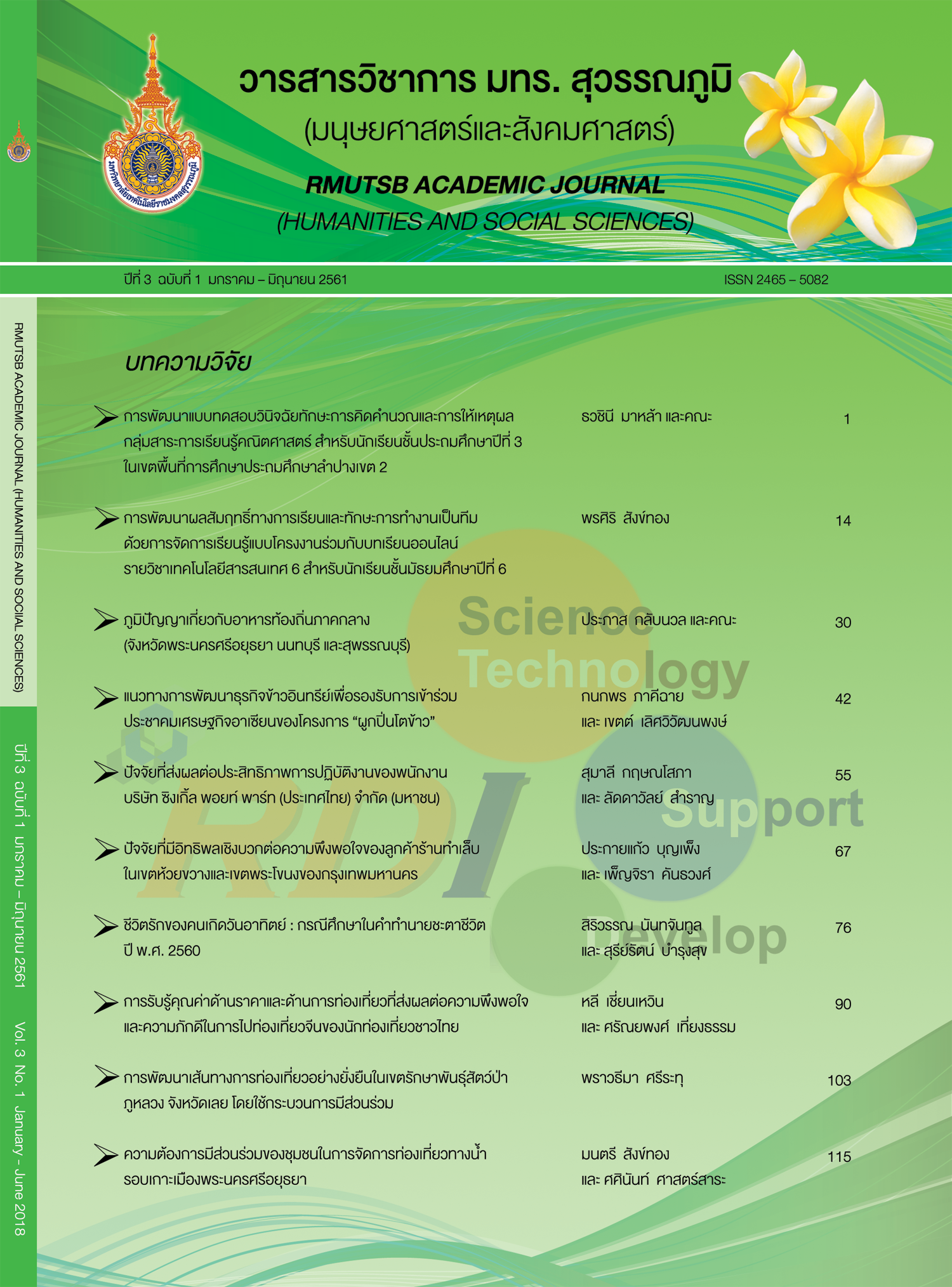Route development for sustainable tourism at Phu Luang Wildlife Sanctuary, Loei province using participation process
Main Article Content
Abstract
The purpose of this research was to develop a route along Phu Luang Wildlife Sanctuary, Loei province for sustainable tourism. The researchers followed four steps of participatory research: 1) survey research to explore the needs of 384 tourists and involved officers with holistic and analytical questionnaire by interviewing 14 Phu Luang Wildlife Sanctuary officers; 2) development of the sustainable tourism routes through collaborative workshop with the Wildlife Sanctuary officers on exploration and verification of potential sustainable tourism routes on an informative basis for future tourist routes; 3) experimental research using one-shot case study design and simulated tours to measure satisfactions of 20 tourists through questionnaire; and 4) developmental workshop between the researchers and the Wildlife Sanctuary officers to study problems, threats and improvements of the tourist routes.
The findings were as follows; Holistically, the tourists reported a high need for a sustainable tourism route along Phu Luang Wildlife Sanctuary, Loei province which was consistent as officers’ comments. Three potential tourism routes in Phu Luang Wildlife Sanctuary, Loei province, included: 1) Lan Suriyan; 2) Nature routes; and 3) Pakdum. Lan Suriyan and the nature routes were verified as the potential tourism routes. Based on holistic and analytical questionnaire items, the tourists reported high satisfactions toward the potential tourism routes identified by the researchers. The data collected during collaborative workshop also revealed two potential tourism routes: 1) Lan Suriyan route, which lasts 1.7-1.8 kilometers; and 2) Pha Chang Pan and Dinosaur footprints' nature route, which lasts 4.8 kilometers.
Article Details
References
ฉลอง สุนทรนนท์. 2548. การวิจัยและพัฒนาศักยภาพเส้นทางการท่องเที่ยวลุ่มแม่น้ำเจ้าพระยาลุ่มแม่น้ำป่าสัก เขตอำเภอพระนครศรีอยุธยา อย่างเป็นระบบและยั่งยืน. รายงานวิจัย. มหาวิทยาลัยราชภัฏพระนครศรีอยุธยา, พระนครศรีอยุธยา.
ฐิตาภรณ์ เวียงวิเศษ, ขนิษฐา ศรีตะวัน, ดวงใจ ลิ้มอำไพ และอารีรัตน์ เมืองแสน. 2550. การพัฒนาเส้นทางการจัดการท่องเที่ยวแหล่งอารยธรรมขอมในเขตอีสานใต้ถึงปราสาทนครวัดประเทศกัมพูชา. รายงานวิจัย. มหาวิทยาลัยราชภัฏบุรีรัมย์, บุรีรัมย์.
ทัศไนยวรรณ ดวงมาลา. 2557. การวิเคราะห์แหล่งท่องเที่ยวเพื่อกาหนดเส้นทางการท่องเที่ยวจังหวัดชัยภูมิ ตามการแบ่งส่วนตลาดตามวัย. วิทยานิพนธ์ ปรัชญาดุษฎีบัณฑิต. มหาวิทยาลัยขอนแก่น,ขอนแก่น.
นิคม บุญญานุสิทธิ์, วิรุฬ ลีวงศ์ และชาตรี ควบพิมาย. 2550. การศึกษาแนวทางการกำหนดรูปแบบเส้นทางจักรยานเพื่อสนับสนุนการท่องเที่ยวในพื้นที่อีสานใต้. รายงานวิจัย. มหาวิทยาลัยเทคโนโลยีราชมงคลนครราชสีมา, นครราชสีมา.
บุญเลิศ จิตตั้งวัฒนา. 2547. การวางแผนพัฒนาการท่องเที่ยวแบบยั่งยืน. คณะมนุษยศาสตร์ มหาวิทยาลัยเชียงใหม่, เชียงใหม่.
พันธุ์ชนก แชมเบอร์ส. 2551. แนวทางการพัฒนาและส่งเสริมแหล่งท่องเที่ยวเชิงประวัติศาสตร์ศิลปะเขมรในประเทศไทยกรณีศึกษา: การจัดรูปแบบเส้นทางการท่องเที่ยวใหม่ ในเขตอําเภอเมืองลพบุรี จังหวัดลพบุรี. การศึกษาค้นคว้าด้วยตนเอง ศิลปศาสตรมหาบัณฑิต. มหาวิทยาลัยนเรศวร, พิษณุโลก.
ภัคณิษา อภิศุภกรกุล และกุลกันยา ศรีสุข. 2550. การพัฒนาเส้นทางการท่องเที่ยวเชิงวัฒนธรรม เชื่อมโยงกับเทศกาลการท่องเที่ยวประจำปี ในกลุ่มจังหวัดภาคอีสานใต้. รายงานวิจัย. มหาวิทยาลัยราชภัฏบุรีรัมย์, บุรีรัมย์.
วิภาวรรณ ปิ่นแก้ว. 2551. การศึกษาเพื่อเสนอเส้นทางท่องเที่ยวเชิงนิเวศน์ในอําเภอเมือง จังหวัดเพชรบุรี. ปริญญานิพนธ์ วิทยาศาสตรมหาบัณฑิต. มหาวิทยาลัยศรีนครินทรวิโรฒ, กรุงเทพฯ.
สฤษฏ์ แสงอรัญ. 2549. การท่องเที่ยวเชิงอนุรักษ์. (ระบบออนไลน์). แหล่งข้อมูล: http://www.dnp.go.th/npo/Html/Tour/Eco_
Tour.html (31 สิงหาคม 2560).
Cochran, W.G. 1977. Sampling techniques. 3rd ed. John Wiley and Sons Inc, New York.


